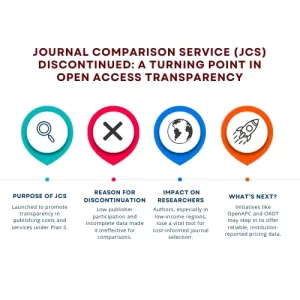Is there vagueness in concepts or definitions in the literature?
April 21, 2025
AI Tools in Scholarly Publishing: Enhancing the Integrity and Efficiency of Research
April 24, 2025Coalition S Discontinue Journal Comparison Service: Open Access Price Transparency Contention Setting

April 24, 2025, PhD Assistance
The news of the coalition S decision of stopping the Journal Comparison Services (JCS), which was effective from April 30, 2025, has captured the significant attention of the global research community. The decision would mark a seminal event in the developments of the conversation on transparency in Open Access (OA) publishing, not to mention the high stake attached to questions regarding scalability and sustainability in fee disclosure initiatives in the scholarly communication ecosystem.
Origins of the Journal Comparison Service: An Initiative Towards Transparency
The opening in September 2022 revealed Journal Comparison Service as a part of cOAlition S’s all-inclusive plan for implementing Plan S, which aims to quicken the full and immediate Open Access. The JCS has been aimed to further publishing fee transparency by allowing authors, funders, and institutions to compare editorial services, peer review practices, rejection rates, turnaround times, and article processing charges (APCs) across journals.
JCS arose from long-lasting complaints of academic authors and research funders about the opaque pricing practices of high-impact journals. The idea was to be corrective to the segmentation of market – corrective tool and would impart pressure on publishers to justify their APCs through specifics of services rendered.
Major Challenges: Nonparticipation of Most Publishers and Incomplete Data
Though bright, the JCS has from the beginning been hampered by very low publisher participation. Most major commercial publishers were either unwilling or forbade to give a detailed accounting of their costs and services. The absence of rewards for regulatory carrot and the voluntary nature gave little chance to have data coverage to be robust.
Without critical mass and comprehensive representation, the comparison tool failed to offer a statistically meaningful or reliable dataset. Researchers often encountered incomplete profiles, non-uniform reporting formats, and a lack of contextual explanations, effectively defeating the purpose of making informed comparisons between journals.
A spokesperson for cOAlition S listed this as a limitation:
“Although we remain committed to price transparency in academic publishing, the JCS has not met the level of participation required to be a useful tool for authors.”
The general feeling represents a more generalized skepticism about the capability of voluntary transparency frameworks in a field that is still primarily under the control of commercial confidentiality and proprietary editorial formats.
Implications for Authors and Institutions
Most disappointed with the winding up of the JCS in its operational existence are scholarly stakeholders in the low- and middle-income countries where funding limitations force them to painstakingly consider their selection of OA journals and balancing costs and benefits in getting them. Again, in such an uncharted territory of fragmented publisher-hosted data, authors seeking fairer value for money must fend for themselves.
Institutions and consortia that had begun to use JCS for informing transformative agreements and library purchasing strategies would now face another gap in the service-level cost transparency. The early-career researchers who tend to rely on structured forms of support for choosing their publishing outlets now find themselves back into using scattered third-party tools and subjective journal reputation metrics.

What Comes Next? Alternative Strategies and Sector Expectations
The winding up of JCS puts a spotlight on an important question: how would one create mechanisms for price transparency in OA that are effective and sustainable in the scholarly publishing world?
Some observers say that regulatory mandates, rather than voluntary participation, is the only way to bring the big publishers to the table. Others argue for a standardized reporting framework managed by an independent data aggregator, possibly set under the auspices of funders’ coalitions or intergovernmental organizations.
These new initiatives-the Open Access Data Trust (OADT) and OpenAPC are being watched with great interest as possible successors or complements to those originally expected from the JCS. These platforms purport to get real-world publishing costs through institutional reporting instead of via publisher self-disclosure, likely improving the data integrity and coverage breadth.
Contextualization: Transparency is One Pillar of Plan S
This development also highlights the overarching framework of Plan S, the pillars of which include immediate Open Access, rights retention, and cost transparency. Whereas Plan S has been landmarking in its success at enforcing OA mandates to publicly funded research, one main impediment continues to be the commercial resistance against cost transparency.
Observers note that the market-driven nature of scholarly publishing combined with consolidation among publishers is going to pose great friction in operationalizing transparency at scale. Thus, for Plan S and cOAlition S, the next hurdle will be rethinking how transparency gets enforced and finding scalable, low-barrier solutions that can serve authors, funders, and readers alike.
Conclusion: Is This a Strategic Pause or a Permanent Retreat?
The suspension of the Journal Comparison Service by cOAlition S is both a practical acknowledgment of operational limitations and a symbolic setback for Open Access advocacy. It could, however, be seen as a strategic pause rather than a total abandonment of transparency aims; however, it further enhances the burdens of others in the system: research institutions, funders, service providers.
At present, the academic publishing world is confronted with the realization that price transparency remains an unsolved challenge, even in the digital access and open data period. Whether such tools will outweigh the obstacles that impeded the JCS remains an open question and a question of urgency. Navigate the post-JCS era with PhD Assistance’s expert-led journal selection services to ensure cost-effective, credible Open Access publishing.

